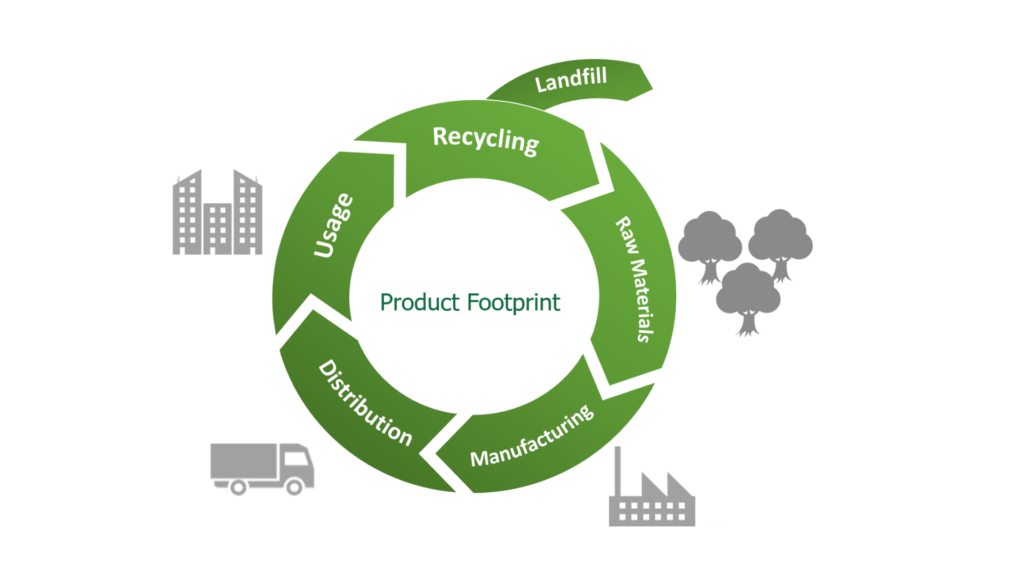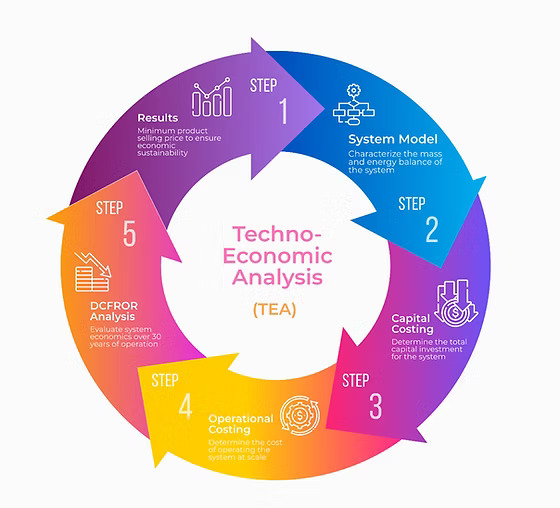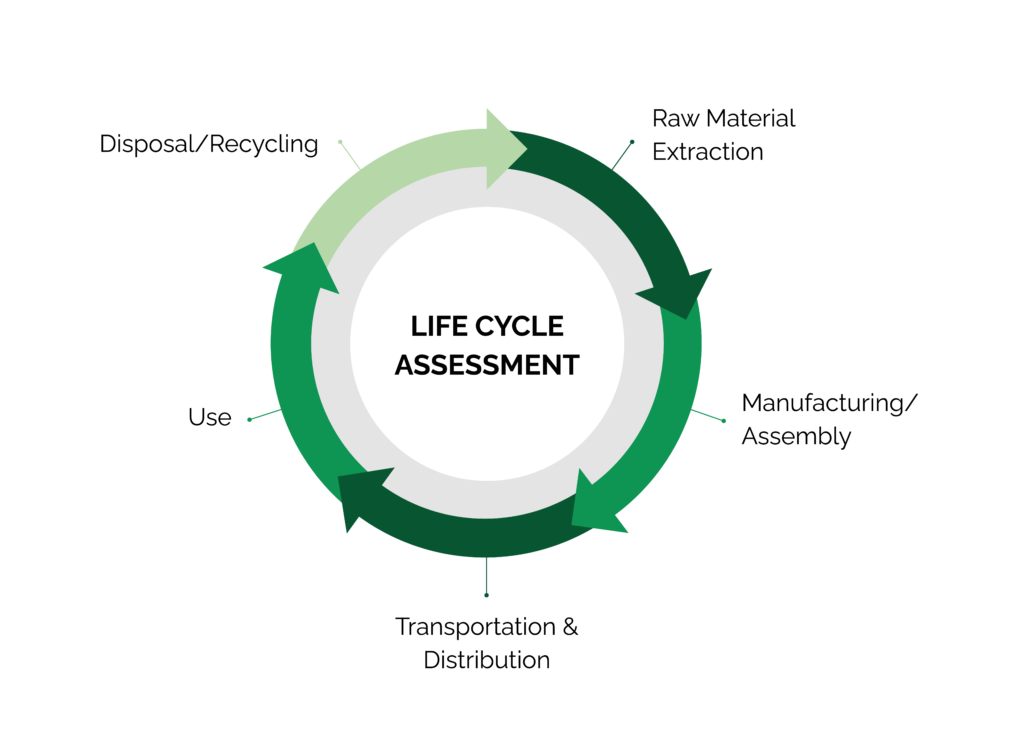The critical role of TEAs and LCAs in sustainable process design

Sustainable engineering is crucial in addressing global challenges like climate change, resource depletion and pollution. By incorporating sustainable practises in engineering design, environmental impacts of processes can be minimised, resources can be conserved and long-term societal wellbeing can be achieved (The role of Sustainability in engineering, 2024).
Technology developers often prioritise the economic performance of new technologies, processes or products whilst the environmental impact is often regarded as a secondary consideration. However, with the increasing environmental concerns we face today, it’s clear that both economic success and environmental responsibility are equally as important to assess and balance.
Two important tools that are used are “Technoeconomic assessments (TEAs)” and “Life cycle assessments (LCAs)”. These methodologies provide comprehensive insight into the technical viability, economic performance and environmental impact of a process or product to enable informed decision making (Mahmud et al., 2021).
Technoeconomic assessments
A technoeconomic assessment is a method of evaluating the technical performance and economic feasibility of a process. It combines process engineering design and economic analysis to assess the economic viability, scalability and market potential of a specific technology (Mandade & Nimdeo, 2022).

Figure 1 – Technoeconomic assessment steps (Sustainability science: TEA, 2025)
In order to complete a technoeconomic assessment, a preliminary design of the process is completed through developing a process flow diagram and a mass and energy balance. The process flow diagram maps out the equipment needed in the process and shows the steady state streams entering and exiting each equipment. The mass and energy balance gives the flowrates and composition of each stream in the process as well as the utility consumption of equipment. Developing this process design requires a thorough understanding of the process steps required to produce a product. It also includes selecting the correct equipment required for the process; sizing/designing the equipment; and calculating flows in and out of the equipment (Perry & Green, 2008).
Following process design, an economic assessment is performed. This utilises the equipment sizes, utility requirements and raw material usages calculated to evaluate the capital and operating costs of the plant (Perry & Green, 2008). A cash flow analysis is carried out to assess the profitability of the plant and a sensitivity analysis is often carried out to observe how varying certain process inputs can affect the economics of the process.
A TEA is a useful tool in decision making as:
- It can help identify where the technical bottlenecks are in the process and suggest improvements to maximise efficiency/ performance.
- It can help identify cost “hotspots” and therefore where priority should be placed for future development and/or optimisation of the process.
- It can help justify further investment for further engineering design work.
Life cycle assessments
An LCA aims to answer the following question:
“How environmentally friendly is the product I am manufacturing/ purchasing?”
A lifecycle assessment is a holistic and iterative methodology that assesses the environmental impacts of a product/process/service across its different life cycle stages (from raw material extraction to end of life) (Hauschild et al., 2018). An LCA study can be cradle-to-gate where a product is assessed until it leaves the factory gates; cradle-to-grave where a product is assessed across all 5 life cycle stages; or cradle-to-cradle where a product gets recycled at the end of its life and re-enters the life cycle (Hauschild et al., 2018).
Figure 2 – Life cycle assessment (Kundu, 2022)
An LCA asks questions like: What raw materials are involved in producing a product? How are these raw materials produced? How is the product itself produced? How much energy is used to produce the product? How was the product transported to consumers? How is the product disposed of/ recycled at the end of its life? Taking all these factors into account can be confusing and therefore having a clear framework like LCA is beneficial in ensuring that all emissions across the supply chain of a product are assessed.
To conduct an LCA, ISO standards 14040/44 are followed. The study consists of 4 phases: goal and scope definition, inventory analysis (LCI), life cycle impact assessment (LCIA) and interpretation (Hauschild et al., 2018):
- Goal and scope definition: This phase consists of outlining the purpose and boundaries of the study. It describes the most important choices taken in the study for example, the reason for the LCA, the functional unit of the study and a description of the system boundaries.
- Inventory analysis: This is the data collection phase where all the material and energy inputs and all the emissions and waste outputs for the product are gathered.
- Impact assessment: This phase is where the data that has been collected is translated into environmental impacts like global warming potential, acidification potential, eutrophication potential etc.
- Interpretation: This phase is where the results obtained from the impact assessment are analysed and environmental hotspots are identified.
There are many benefits to LCAs. The insights from an LCA can help with sustainable product/ process development as “hotspots” or areas with the highest environmental impacts can be identified and hence design changes can be implemented to reduce these impacts. Moreover, the results from an LCA can help with regulatory compliance as the environmental impact data of the product is quantified. The results can also be used for marketing purposes as the data is factual and obtained from a reviewed and comprehensive study. Supply chain optimisation can also be achieved as the whole supply chain is assessed in an LCA and therefore, more informed decisions can be made (Golsteijn et al., 2024).
Combining TEAs and LCAs for sustainable process design in Project ResoURCE
While TEAs and LCAs provide valuable insights independently, their strength lies in their combined use. When used together, these assessments offer a broad view of a process’ performance ensuring cost effectiveness and environmental sustainability.
As part Project ReSoURCE, which aims to develop automated sorting solutions for refractory bricks, the developed ReSoURCE sorting system (aka. the Raptor) will be evaluated using a TEA and an LCA. This will allow for comparison against previously completed TEA and LCA studies on the currently used manual sorting site. By completing a TEA and an LCA for the automated sorting system, valuable insights on the economic and environmental performance of the modular technology can be obtained. These insights can then be used to support its improvement and justify its future implementation at different refractory production plants, contributing to a circular economy.
References
Golsteijn, W. (2024) Life cycle assessment (LCA) explained, PRé Sustainability. Available at: https://pre-sustainability.com/articles/life-cycle-assessment-lca-basics/ (Accessed: 17 March 2025).
Hauschild, M.Z., Rosenbaum, R.K. and Olsen, S.I. (2018) Life cycle assessment: Theory and practice, Springer. Cham: Springer. Available at: https://link.springer.com/book/10.1007/978-3-319-56475-3 (Accessed: 17 March 2025).
Kundu, V. (2022) Life Cycle Assessment explained, STiCH. Available at: https://stich.culturalheritage.org/life-cycle-assessment-explained/ (Accessed: 17 March 2025).
Mahmud, R. et al. (2021) ‘Integration of techno-economic analysis and life cycle assessment for sustainable process design – A Review’, Journal of Cleaner Production, 317, p. 128247. doi:10.1016/j.jclepro.2021.128247.
Mandade, P. and Nimdeo, Y.M. (2022) ‘Techno-economic assessment of biofuel production using Thermochemical Pathways’, Biofuels and Bioenergy, pp. 653–671. doi:10.1016/b978-0-323-90040-9.00029-1.
Perry, R.H. and Green, D.W. (2008) Perry’s Chemical Engineers’ handbook, McGraw Hill Education. New York: McGraw-Hill. Available at: https://www.accessengineeringlibrary.com/content/book/9780071422949 (Accessed: 17 March 2025).
Sustainability science: TEA (2025) Sus Science. Available at: https://www.sustainabilitysci.com/technoeconomicanalysis (Accessed: 17 March 2025).
The role of Sustainability in engineering (2024) Motion Drives and Controls. Available at: https://www.motiondrivesandcontrols.co.uk/blog/engineering-ethics-and-sustainability-building-a-responsible-future (Accessed: 17 March 2025).

Authors’ Portrait
Heidi ElSayed
Heidi is a Process Engineer in the Process Safety and Engineering Team at CPI. She is an associate member of the IChemE. She has experience in process design and scale up, technoeconomic assessments (TEA) and carrying out literature reviews. She also has experience with completing process safety and risk assessment studies like HAZOP and using process simulation tools like Aspen Plus and Aspen HYSYS. Passionate about developing sustainable chemical processes, Heidi is a key member of CPI’s Life Cycle Assessment (LCA) team. Heidi is also a STEM Ambassador where she volunteers to help encourage young people to get involved with STEM through different activities.
Partner

